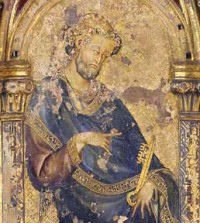Westminster Retable

The Westminster Retable, the oldest known
In 1998 the
Description

The retable measures 959 x 3330 mm (approximately 3 feet by 11 feet) and is painted on several joined oak panels using thin glazes of colour in linseed oil on a gesso ground.[2] The construction is complex, with six main flat panels, and several other wooden elements.[1] The retable is divided into five sections by gilded wooden arcading,[6] with pastiglia relief work, elaborate glass inlays, inset semi-precious stones and paste gemstones, to imitate the lavish goldsmith's metalwork found on some surviving retables and shrines on the Continent, and the now destroyed Shrine of Edward the Confessor installed in the Abbey in 1269.[7]
The composition has a central section with three tall narrow openings defined by tracery containing full-length figures of Christ holding a globe as

The painting is of very high quality, probably by an artist used to working on illuminated manuscripts, to judge by the fine detail of the work, and some stylistic details. In its position on the high altar the detailed images would only have been clearly visible to officiating clergy, and no concessions were made to more popular taste.[10] The tiny globe held by Christ is painted with four registers of scenes showing animals, trees, and a man in a boat.[9]
History
After the
In 1827, the Retable was seen by the architect
It is currently housed in a glass frame to protect it from further deterioration. From 1827 to 1902, the Retable was kept in the Jerusalem Chamber, before being moved to the south ambulatory. It was later displayed in the Westminster Abbey Museum, along with Pitt and the other wax effigies, until the museum closed for redevelopment.[18] Since 2018, the Retable has been on display in the Queen's Diamond Jubilee Galleries in the abbey's triforium.[2]
Notes
- ^ a b c d Hamilton Kerr Institute Archived 5 May 2011 at the Wayback Machine, with full image of the retable, accessed 13 July 2010
- ^ a b c d "Retable". Westminster Abbey. Retrieved 4 May 2023.
- ^ "Westminster Retable: England's Oldest Altarpiece" Archived 7 May 2009 at the Wayback Machine, National Gallery Exhibition Description, and accompanying press release Archived 16 June 2008 at the Wayback Machine. Retrieved 24 December 2008.
- ^ Tudor-Craig, 105
- ^ "The Westminster Retable at the National Gallery" Archived 20 November 2008 at the Wayback Machine, The Electric Review, by Bunny Smedley, 27 May 2005. Retrieved 24 December 2008.
- ^ "Westminster Retable", Westminster Abbey: From 1065 to Today. Retrieved 24 December 2008.Image
- ^ Tudor-Craig, 115-6. For example the Pala d'Oro in Venice (compared by Tudor-Craig, 102), or the Shrine of the Three Kings in Cologne.
- ^ [1], Tudor-Craig, 103.
- ^ a b Tudor-Craig, 102-3
- ^ "The Westminster Retable", published in Magazine Antiques, by Miriam Kramer, November 2005. Retrieved 24 December 2008.
- ^ Bunny Smedley, website of The Social Affairs Unit, with a fuller description.
- ^ 1827, Part I, p. 251 (Binski 1988:129 note 5.
- ^ Binski 1988:129.
- ^ Paul Binski, "The Earliest Photographs of the Westminster Retable" The Burlington Magazine 130 No. 1019, Special Issue on English Gothic Art (February 1988:128-32); the retable was first photographed in 1897
- ^ Vol. I (Paris, 1858) plates IX and XXII (noted by Binski 1988:129 note 6).
- ^ Included in the second edition of George Gilbert Scott's Gleanings from Westminster Abbey (1863).
- ^ Binski 1988:129.
- ^ Westminster Abbey, BBC image of the panel on display
References
- Tudor-Craig, Pamela, in: Wilson, Christopher and others: Westminster Abbey, Bell and Hyman, London, 1986, ISBN 978-0-7135-2613-4
Further reading
- Binski, Paul ; Ann Massing (eds); The Westminster Retable: History, Technique, Conservation, Turnhout: Harvey Miller, 2008, ISBN 978-1-905375-28-8
- Macek, Pearson Marvin. 'The discoveries of the Westminster Retable, 'Archaeologia, 109 (1991), 101–11. Publisher: Society of Antiquaries of London. ISSN 0261-3409(and his unpublished thesis at Michigan Univ, Ann Arbor, 1986)
